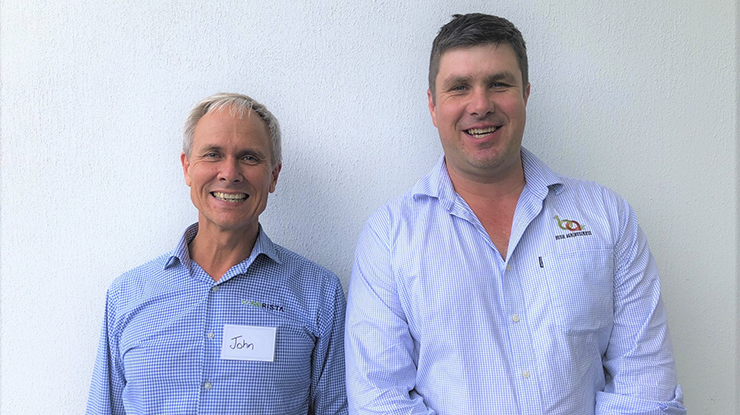 John Francis from Agrista (NSW) and Ian McLean from Bush AgriBusiness (QLD)
John Francis from Agrista (NSW) and Ian McLean from Bush AgriBusiness (QLD)
Business EDGE: Top tips for a more profitable farm business
Key points
- Business EDGE workshops help upskill northern and southern producers to understand what drives profitability within their business.
- More than 15 Business EDGE workshops will be held across Australia in 2023. Check the MLA events calendar to find a workshop near you.
- To be as profitable as possible, producers should identify what their business and personal goals are and how their enterprise can achieve them.
- Business owners should upskill and develop their financial literacy so their business can be as successful and profitable possible.
Business EDGE workshops are back for 2023 and are set to equip producers with the business and financial skills needed to grow their business into the future.
With over 12 years’ experience delivering the Business EDGE training course to the agricultural and pastoral community, Ian McLean from Bush AgriBusiness (QLD) and John Francis of Agrista (NSW) are well equipped to help farm businesses plan for profit.
Both part of a network of experienced deliverers offering the Business EDGE program, they are teaming up to co-deliver a Business EDGE workshop in St George on 23–24 March.
Meat & Livestock Australia’s primary financial literacy training package, Business EDGE, helps upskill mixed enterprise and red meat producers in business knowledge and how to make the best decisions for the future of their enterprise.
“The core principles are basically about business content and business figuring.
“Whether you’re managing a northern cattle enterprise or looking to future-proof your family farm, the course helps build skills to tackle your business goals,” John said.
Here, John and Ian share their insights on the workshops, including top tips for producers planning for profit in 2023.
Business EDGE: What the course covers
1. What is a good, sustainable, business? What do you want to achieve?
Looking at what you want your businesses to achieve, what success looks like and what level of performance is required to achieve these goals.
2. The basics of financial literacy: the language of money
How to use and review reports using general business principles and general business terms that are used in the wider business world but applying them to agriculture. Knowing what the numbers mean, where they come from, and how to generate them for your own business.
3. Interpretation: looking at numbers and what they are telling you
Assessing where your business is performing well and where it’s not. Looking at how to assess and manage risk. How to ask questions and manage relationships with financiers, what the limits are and how to ensure that you’re meeting your financial objectives from a business planning perspective.
4. Managing and allocating working capital.
Reviewing all the ‘little things’ that you do on-farm, the little investments you make and how they contribute to whole farm profitability.
Top tips
Identify your goals for the business and for each stakeholder. What kind of performance is needed to achieve them? Understand and explore what your strengths, limitations and areas for improvement are. Make a clear, articulate, strategy of how to get there and what your success looks like. Work out where you want to get to in terms of expansion, succession, retirement, children’s education and provisional expenses.
Make it a business that provides for you in the long term. Be aware that you need to have more business skills than you needed in the past and to be informed enough to be able to assess the advice you’re getting and how to apply that to your business.
Look at your big picture and what it should look like, for example, 10 years in the future. The enterprises that are more profitable aren’t getting a higher price received. They are meeting their long-term objectives and profitability with more efficient businesses, more production and lower cost of production. What does that look like and how do you get there?
You didn’t know how to drive a tractor successfully first go. Understand you must spend time on growing your financial literacy to build the skills that delivers the outcome. By doing so, you can link what’s happening out in the paddock with what’s happening in the numbers and the drivers of your success or limits.
You’re the one who must drive the operations performance of the business and you’re the one who has to own the business. You must have the ability to interpret numbers to accurately make decisions that affect you, your family and your farm.
According to John, Business EDGE workshops are a starting point to allow you to understand some of the complex relationships in your farm business.
“It’s essential to understand that productivity and efficiency measures are the profit drivers.
“Whether its labour efficiency, stocking rates or kilos per animal per hectare, assessing all of those components puts the pieces of the puzzle ahead of you and allows for a better understanding of your business performance.”



